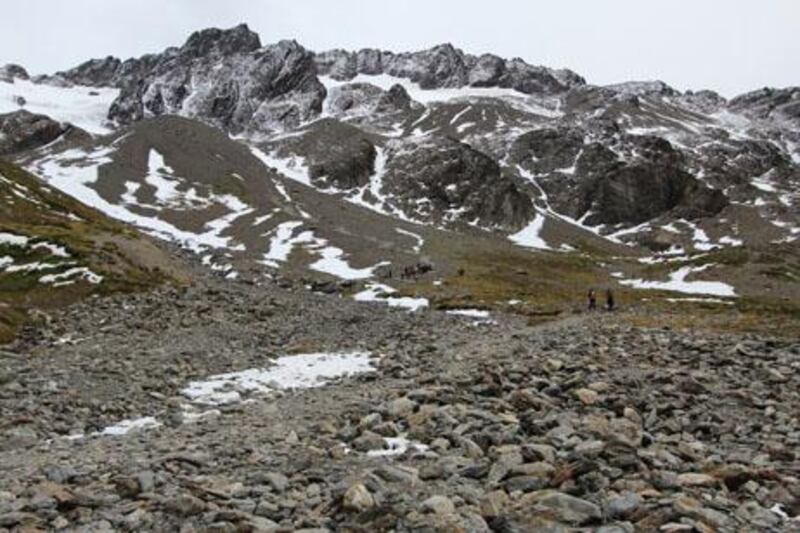Reem Al Junaibi and Maitha Al Kaabi, students from the Masdar Institute of Science and Technology and members of the International Antarctica Expedition 2012 team, write about their experience.
Day 1: Reaching Ushuaia
Reaching Ushuaia was a challenge by itself. The flight was very long but worth it. We stayed one night in Buenos Aires and travelled the next morning to Ushuaia. The first glance of the city I had was from the plane. As the clouds cleared, we saw the mountains topped with snow right next to the ocean. Our journey from the Arabian desert has taken us to the southern-most city in the world.
Day 2: Hike up the glacier
We started the day after a healthy breakfast and got ready to hike up the mountain to witness the melting glacier. We were divided into groups and we had to work our way through the mountain as a team. We were guided by the '2041' team leaders every few kilometres. We hiked about 5km and reached the highest point of the climb which was about half the height of the mountain side. This activity was designed for us to work as a team because we were tied together in ropes. I was in the front leading the team and we had to make sure we all walked at the same pace. This was challenging because of the height of the mountain.
This activity is a kind of a metaphor for the real world. We can look at sustainability as the top of the mountain and ourselves as different companies or nations. We all need to reach the top but we are tied together. The only way we could reach the top was by collaboration and looking out for each other.
Polar explorer Sir Robert Swan was waiting for us near the top and motivated us to push further to reach the top. Me and Maitha successfully reached the top and it felt amazing and disappointing at the same time. It was disappointing because we witnessed how the glacier has melted and it literally became nothing but a little snow.
During our hike, we had interesting discussions about the Masdar Initiative and the one shared comment we got from everyone was how amazing and ambitious the UAE is to build a low-carbon city. We felt proud to be a part of the overall Masdar initiative and everyone in the team was inspired by this vision.
Day 3: Leaving Ushuaia
We started the day by having a meeting and a very inspirational speech by Sir Robert Swan. We discussed several issues related to sustainability in groups. I found it very interesting how everyone had a totally different opinion. Although we all gathered in Ushuaia to reach the same destination, we all have different experiences, expectations, and predictions of the future. Some people emphasized the importance of education while others focused on innovation and others on population.
We were asked to find the major issues the world is currently facing and what we need to focus on to achieve sustainability. There was no single answer. This helped me to understand why negotiations and global policies are very difficult to implement. Our 78 members could not come up with a single answer or several at least. Imagine if it were negotiating on certain policies that would affect millions.
After checking out and sending as many emails as I can from the hotel lobby (the ship had limited connection) I called my family and friends to say goodbye and then went downtown to the meeting point with Maitha and prepared to enter our new home, the Sea Spirit. I expected bunkers and very small rooms with narrow hallways. It turned out to be the opposite. The ship was like a five-star hotel. It has a reception, gym, library, and a very nice dining room.?However, our resources were finite. For example, we have limited water, food, and essential items.
We will pass the Drake Passage and it is hard to predict how the weather will be. It is like travelling to the unknown. So we have to consume every luxury we have with utmost care. This is similar to what the world is facing. We have finite resources and we are all on a ship travelling to the unknown.
Day 4: Drake Passage
This day was one of the most difficult. Many got seasick. We were surrounded by the ocean and could not see land around us. I could see the curve of earth's crust just by standing on the ship's deck. There was nothing blocking my sight. The waves were rough and I was shocked because the crew said; "The Drake is very good". We were warned by the organisers that the Drake Passage is the most aggressive passage any ship can go through. They say that to reach Antarctica, you have to pay the "Drake tax". We were lucky enough that the Drake was not as aggressive as it usually is.
Another thing we had to do is to "Drake-proof" all our belongings by making sure everything was secured and placed inside drawers to avoid any accidents.
During the day we had several lectures about wildlife in Antarctica. We learned about albatross and also had a chance to see some gliding by the ship. What interested me the most is that the albatross can travel up to 25,000 kilometres in six months, and, depending on the species they can live more than 60 years. These very large sea birds do not flap their wings very often to fly. Instead, they save their energy by not flapping their wings and only spread them to use the wind to fly.
?






